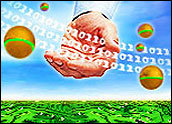
In today’s world of hybrid cars and wind farms, consuming energy wisely is on every individual’s agenda. Companies and their IT departments should be no different. Statistics aside, there is no doubt that collectively data centers have a huge “carbon footprint” and are the biggest or one of the biggest consumers of energy in every company. You have already heard about how it is only a matter of time until companies will be forced to make data centers green as a part of their effort to reduce their carbon penalty. If you think this issue is going away, think again.
Companies have already started planning for data centers built on alternate energy sources, such as solar and wind power. While it may be a while before those options become commonplace, there is no reason why companies cannot start taking baby steps. Efforts to utilize current technology and methodologies that will reduce the amount of electricity consumed and reduce the amount of heat generated (hence reducing your air-conditioning bills) can be combined with other subtle efforts that directly and indirectly change the way in which you think about energy in the data center.
A lot of “out of the box” server and storage technologies — such as virtualization, thin provisioning, low-consumption hard drives, etc. — allow companies a jump-start on this effort, so that when the time comes to really put this into action, you will be ahead of the crowd. However, in order for companies to measure their success, they need to first establish a baseline and create a roadmap; i.e., they need to know where to start and what to accomplish in a prioritized manner. Once a company starts its journey, it can measure its success along the way. The key thing to keep in mind here is that this is not an overnight change, but rather a multi-year journey that provides benefits in an incremental manner as initiatives are accomplished.
A data center energy audit, in short, is a good way to start this initiative. Several companies are beginning to offer this service as a part of their core portfolio. The focus of this service is essentially to make data centers as efficient as possible and to provide prioritized and actionable recommendations to achieve that target state. There are a lot of misconceptions and pitfalls in this field — a wrong move could easily lead to a wasted investment. Starting with this service should therefore help companies ensure that their investment is made in the right direction.
Most data center audits include various proficiency analyses. One key that applies to green initiatives should be cost proficiency (i.e., a way to identify, consolidate and streamline cost savings). At the same time, a green proficiency analysis provides you with a “blueprint” to achieving a more efficient, greener IT environment based on industry standards such as those established by organizations like the Green Grid.
Data Center Infrastructure Efficiency and Power Usage Effectiveness
The Green Grid defines these two metrics as ways to determine the operational efficiency of a data center. Depending on the units used and the process used to measure these metrics, they (one is the reciprocal of the other) provide a comparison between total facility power and IT equipment power. The total facility power is the amount of power being consumed by the data center as a whole and includes everything housed in the data center. IT equipment power is the sum of all the power consumed by systems, storage, network equipment and any devices that directly form a part of IT in that company and are housed in the data center. Therefore, it is safe to say that IT equipment power is a subset of the data center.
These metrics can be used to improve the operational efficiency of a data center, and when used in a normalized manner (i.e., accounting for per-data center specifics such as location, etc.), they can be used to compare various data centers (i.e., to establish a baseline for comparison). If a company has multiple data centers, these values can provide information on which data centers are the most efficient and which ones are not. They help in determining the impact of other green initiatives mentioned above. For example, a virtualization initiative can help in reducing IT equipment power consumption, thereby impacting these metrics in a positive manner.
Datacenter Space Optimization
While this metric is up for interpretation, it is an important one to measure “how full” the data center is. The lower this value, the more inefficient the data center. This is because it implies that the company is essentially paying to cool and light up a lot of empty space. DCIE (data center infrastructure efficiency) and PUE (power usage effectiveness) numbers should indirectly lead you to this conclusion, but keep in mind that the above values are not a function of physical space. With a certain amount of space left for growth, companies should strive to keep their data center occupancy at healthy levels. Too many data centers with low space utilization should be immediate grounds for data center consolidation.
However, the effort should not stop there. Rack utilization and efficiency is also important. It also goes hand in hand with how the data center has been designed for rack placement (to optimize cooling and power). Rack utilization should be based on trying to ensure the highest average rack unit (RU) consumption in the data center. So if a rack unit is 44 units, then the average consumption should be as close to the theoretical as possible — the higher the overhead, the lower the efficiency. If there is higher overhead, examine why it is the case. Is it due to cooling? Is it due to poor cable management or rack rails? Or is it simply poor planning in how and where to place systems?
Infrastructure Efficiency
Another indirect interpretation of the DCIE and PUE metrics is the efficiency of the DC infrastructure.
Cooling tends to have the biggest impact, as the biggest “emission” from IT equipment is heat. If the data center cooling infrastructure is not mated well to the data center profile (in terms of the heat generation, air flow in and around the racks and the placement of cooling units in the data center), then the company is generally at a high risk of either being under-protected or overpaying. The quality of the equipment used is a key element in this matter. Older equipment tends to consume more energy, so a data center operation should include life cycle management of facilities equipment as well.
Another key area of data center infrastructure is standby power. The UPS (uninterruptible power supply) and standby power-generating capabilities of the equipment should be mated to the data center power consumption requirements. The amount of time the data center needs to stay on standby UPS power and subsequently on generator power should be dictated by the company’s DR strategy and RPO/RTO requirements. If the company has a warm standby or active disaster recovery facility, it could afford to have smaller reserve standby power, thereby minimizing ongoing consumption.
Cable management can present another big challenge in a data center. An efficient data center should be designed to minimize wastage. Wastage is often caused by a “home run” system because cables generally have higher failure rates due to human accidents. During such times, there is wastage because the old cable stays intact, whereas a new one has to take its place. Over time, it adds to a lot of wasted copper or fiber.
IT Equipment Efficiency
An article on data center efficiency cannot be complete without a discussion on the efficiency of the equipment that consumes so much of the data center’s assets.
There is no doubt that every company should examine and implement some or the other form of systems virtualization. This article does not deal with the various types of systems virtualization out there; however, it is enough to mention that there are many different products out there and there should be an effort to determine which option best suits a company’s needs. The goal of virtualization should be simple — to reduce the physical server footprint in the data center and therefore the amount of energy consumed.
However, the buck does not stop there. Newer storage technologies such as thin provisioning allow companies to improve storage utilization, thereby reducing the amount of “idle, spinning disk” that is deployed. Similarly, technologies such as MAID (massive array of independent disks) ensure that disks can be spun down (and powered off) when not in used. Storage tiering ensures that all of the data is not stored on the fastest disks available (faster generally means more power consumption). Explore solid state drives. They are here to stay, and their prices will only go down. What about storage reclamation? If you find yourself not being able to answer this question, consider this: The average storage consumed by a server is 20pc. Beyond that, all space is wasted. If the server no longer needs the storage, is there a way you can reclaim it? The answer is yes, and it directly leads to better storage management.
Retiring old equipment in a timely manner should be on everyone’s list of things to do. A data center audit, if performed periodically, should expose equipment and servers that are not in use. Such equipment should be powered off and hauled off the data center floor as quickly as possible.
In Conclusion
IT budgets are not increasing, but companies are faced with an ever-increasing demand and need to support a growing business and new initiatives. A green initiative should not be looked upon as anything separate, but rather one of the core drivers for initiatives, such as streamlining IT infrastructure and reducing operational costs and/or capital expenditures.
Being able to measure the impact of this driver before and after is the right way to get started.
Ashish Nadkarni is a principal consultant at GlassHouse Technologies.













































Social Media
See all Social Media